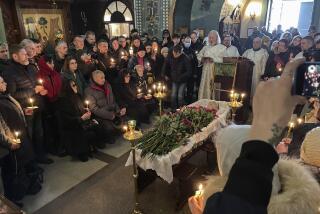Milosevic’s Body Is Returned to Serbia
- Share via
BELGRADE, Serbia and Montenegro — The coffin slid down the luggage conveyor after a baby carriage, several large cartons and suitcases as a few friends gathered on the runway under a fine snow Wednesday to welcome home the body of former Yugoslav President Slobodan Milosevic.
Then the coffin was draped with the Serbian flag and slid into a rented hearse for the journey to a state hospital morgue where the body would be held overnight.
Milosevic will be buried Saturday in his hometown of Pozarevac.
A few hundred supporters, many of them elderly, gathered on the road leading out of the airport into Belgrade. A few chanted briefly “Slobo the hero!” and flung red flowers onto the hearse.
It seemed a forlorn moment in many ways for the man whose party used to turn out hundreds of thousands of supporters to cheer him. On Wednesday, there were no government dignitaries on hand to meet the body. The rented hearse, the company name in letters along with its phone numbers on the back, underscored the sense that official Serbia had all but disowned the late war crimes suspect.
An effort by the Socialist Party he once led to have his body lie for two days at a Belgrade museum so that supporters could mourn him was rejected by Dragan Kojadinovic, Serbia’s minister of culture. Kojadinovic explained that there was an exhibit of Iranian clothes and another of Chinese coins, so the museum was full and could not accommodate Milosevic’s body.
The fight is still going on about where to put the body for the two days of mourning before the burial. One possibility is a second museum in an affluent Belgrade neighborhood where the former leader once lived.
Milosevic was found dead Saturday in the U.N. detention center at The Hague, where he was being tried on charges of genocide and war crimes before the International Criminal Tribunal for the Former Yugoslavia. His case was officially closed Tuesday. Milosevic was alleged to have orchestrated the Balkan wars of the 1990s that raged across Bosnia-Herzegovina, Croatia, Slovenia and Kosovo province, killing more than 225,000 people.
Preliminary results of an autopsy showed that he died of heart failure, but questions lingered about the exact circumstances of his death. Those questions include whether the looser security rules that applied to him because he was preparing his own defense may have allowed visitors to smuggle him drugs that were not prescribed by Hague doctors. Traces of a powerful antibiotic that could negate the effect of other drugs, including the beta blockers and other heart medicine that Milosevic was taking, were found in his system.
The results of a toxicological examination are expected this week.
Pathologists in Serbia are performing a second autopsy because of suspicions among Serbs loyal to Milosevic that he was a victim of foul play.
After five days of sometimes near farcical arguments among members of the Milosevic family and also among the family, Milosevic’s party brass and the Serbian government, a compromise was reached to allow his widow to return to Serbia so that Milosevic could be buried here. It remained uncertain late Wednesday whether his wife, Mirjana Markovic, who lives in Moscow, and his son, Marko, would come to the funeral.
Markovic faces corruption charges in Serbia. A Belgrade court agreed to suspend the charges so she would not be arrested if she entered the country for the funeral but ordered that her passport be taken to ensure that she appears in court for a hearing March 23.
Marko Milosevic, who is alleged to have cheated various Balkan organized crime rings involved in cigarette smuggling operations, is thought to be in danger of being killed if he comes to Serbia.
The decision to have Milosevic buried at home was driven in part by members of the Socialist Party in an effort to build a myth about Milosevic that reminded people of Josip Broz, known as Tito. Tito, who helped forge the former Yugoslavia out of the ruins of World War II, is buried in the garden of his Belgrade home.
For the many who suffered under Milosevic, the efforts to give him dignity in death and turn him into a martyr seemed like an insult.
“We talk about the dignity of the funeral and this is the man who killed his predecessor and buried him standing, covered in lime in the forest,” said Branka Prpa, the widow of Slavko Curuvija, a newspaper editor whom Milosevic allegedly ordered killed during the U.S.-led NATO bombing of Yugoslavia in 1999. The man covered in lime was the president of Serbia before Milosevic, Ivan Stambolic, who was kidnapped while jogging in 2000 and found dead three years later in a mountain forest about 40 miles from Belgrade.
But for Milosevic’s supporters, many of whom lost their jobs during the 1990s as their country came under United Nations sanctions and was beginning to move toward a market economy, the former president was someone who gave them pride, a sense of belonging to something larger. They believed his version of why the 1990s wars were necessary: to defend those Serbs who remained in the newly independent republics such as Bosnia and Croatia, which Milosevic described as hostile to Serbs.
“Milosevic meant safety; he was for the preservation of Yugoslavia and he tried to achieve that. It is a lie that he was a supporter of a Greater Serbia,” said Tomislav Jovanovic, 35, a farmer who drove more than an hour with his 12-year-old son to be at the airport when Milosevic’s hearse went by.
“We all like to live in a strong country so that America cannot do with us what it wants.”
More to Read
Sign up for Essential California
The most important California stories and recommendations in your inbox every morning.
You may occasionally receive promotional content from the Los Angeles Times.










